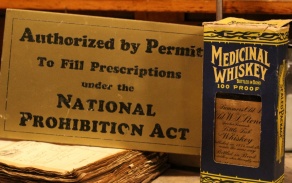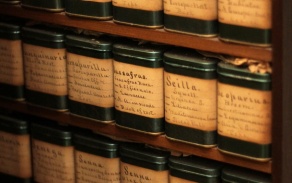Historical Exhibits
The Apothecary, as well as the historical exhibits throughout the school display a wide range of products which were used to treat a variety of illnesses.
Prohibition Products

The 18th Amendment to the US Constitution had an effect on some medicinal products, including what is now known as “patent medicine.” One of the more popular items of this exhibit is a non-refillable National Prohibition Act Prescription Blank on which a physician could use to prescribe alcohol.
Tax Collection Stamp

A special tax stamp issued by the US Internal Revenue Service and purchased by a pharmacy to participate in the retail sales of products containing opium, coca leaves and related ingredients. The stamp was required to be displayed for all to see in the facility.
Medicine Creation Display

Set up on an actual working bench from an early 1900s pharmacy, the medicine creation display contains a variety of tools including a ledger from the late 1800s, a pill roller, tiles and spatulas, a pill coater, pill finishers, suppository molds and presses, emulsifiers, and cutters used in creating medicines prior to the period of mass manufacturing.
Wolfish Container Collection

A member of the Pharmacy Class of 1958, Maurice Wolfish was an avid collector of pharmacy memorabilia. Upon his death, his family donated his compilation to the Apothecary for preservation.
Traveling Herbal Cart

An integral component of pharmacy education involved the study of botanicals. Students were expected to be proficient in knowledge related to plants used in the creation of medicine. The Apothecary contains a mobile cart which was employed for instruction in this area. The cart contains 144 tin containers of herbal samples which are identified by their common name, botanical name, natural order, habitat and the part of the plant that was used.
Cigarettes for Asthma

A popular item in the Museum is Dr. R. Schiffmann’s Asthmador Cigarettes for asthmatics. The cigarettes, sold until the early 1960s, contained stramonium and belladonna, which were viewed as a respiratory decongestant and a muscle relaxant, respectively. The cigarettes were later favored by individuals for their hallucinogenic qualities. By the late 1960s, reports of poisonings multiplied and they ceased to exist.
Western New York Items

The Apothecary and Historical Exhibits contain many products which were made in Buffalo and other parts of Western New York. Some of these items include Doan’s Tonic Tablets, Charles A. Dref’s Whooping Cough Remedy, Gino Pills, Hutch Tablets, Dr. J.D. Kellogg’s Asthma Remedy, Perry’s Original Hed-Ache Capsules, Peterson’s Ointment, and Dr. Sullivan’s Vegetable Compound.
Medical Tools

A number of items from our collection can also be viewed as part of the Robert L. Brown History of Medicine Collection in the Health Sciences Library which is located in Abbott Hall.